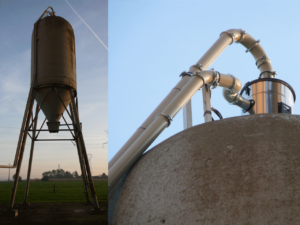
Protect your factory floor with the central vacuum system
Nonostante i capannoni siano “solitamente” spazi semplici da gestire, la loro pulizia spesso risulta essere più complicata del previsto.

Baker's asthma is one of the historically established occupational diseases of the food industry and affects all workers who perform tasks involving exposure to flour dust of any kind.
This disease usually involves a mild form of asthma, caused by inhalation of flour, which can worsen in the presence of an allergic person. In addition, according to several studies, work-related asthma is the most common occupational respiratory disease.
Baker's asthma: the main symptoms
The causes of risk in a bakery, or in any environment where flour is processed, are diverse.
The specific risks vary according to the type of bakery, the structure of the premises and the machinery present, as well as the substances used or produced. The risks of workers employed in bakeries that are most frequently listed in risk prevention manuals are flour inhalation, manual handling of loads, repetitive movements and microclimate.
In particular, it must be considered that the operations with the highest risk of exposure are, according to various studies, those of preparing the dough and cleaning the working environment.
In addition, among the risks there is also that linked to the removal of flour dust itself. In the absence of appropriate safety measures, small particles of flour dust, which can form a large flammable area in contact with the air currents of an extraction system, can cause violent explosions.


The causes of risk in a bakery, or in any environment where flour is processed, are diverse.
The specific risks vary according to the type of bakery, the structure of the premises and the machinery present, as well as the substances used or produced. The risks of workers employed in bakeries that are most frequently listed in risk prevention manuals are flour inhalation, manual handling of loads, repetitive movements and microclimate.
In particular, it must be considered that the operations with the highest risk of exposure are, according to various studies, those of preparing the dough and cleaning the working environment.
In addition, among the risks there is also that linked to the removal of flour dust itself. In the absence of appropriate safety measures, small particles of flour dust, which can form a large flammable area in contact with the air currents of an extraction system, can cause violent explosions.

In the light of what has just been written, it is clear that in order to prevent a pathology caused by exposure to flour dusts, it is essential to create an adequate ventilation system, which, unfortunately, is often absent or lacking in small workshops. In addition to the fact that it is necessary to remember how important it is to use vacuum cleaners capable of eliminating the risk of dust explosion.
Not only that, the Consolidation Act on health and safety protection states that the ventilation system, if installed, must always be kept in working order.
Ultimately, baker's asthma can be prevented above all by adequate cleaning of the workplace, removing any sediment or dirt that could pose an immediate health hazard to workers due to pollution of the air they breathe. In this regard, vacuum systems are also very important for oven cleaning because they prevent the operator from breathing in dust rich in carcinogenic residues.
Other measures to reduce exposure to flour dust include cleaning the work surface, separating work clothes from civilian clothes, and emptying the flour sack if it is shaken.
The causes of risk in a bakery are varied, but with a little attention and prevention, illnesses can be eliminated, or at least mitigated.

Nonostante i capannoni siano “solitamente” spazi semplici da gestire, la loro pulizia spesso risulta essere più complicata del previsto.

The reopenings and the return to normal life have revived consumption, but with such a demand that the production system cannot reorganise itself.

Whether in the food, manufacturing or automotive industries, to name but a few, suction of liquids is notoriously an obstacle.

The Circular Economy Report 2021 estimates annual savings of around €100 billion for Italian industries if circular economy management practices were adopted.

For companies producing and processing dry feed, or similar products such as cereals or flour, transporting the product to storage silos is a process fraught with pitfalls.

Even when you have cleaned a surface, dirt may remain hidden and unseen.
Sistem Air Pro is capable of responding to all professional and industrial sector requests